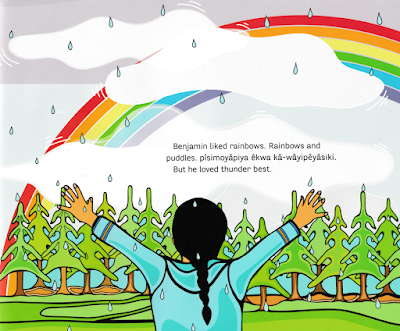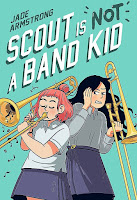Illustrated by Anna Bron
Annick Press
978-1-77321-803-8
120 pp.
Ages 6-9
September 2023
Young Salma, whom we first met in Danny Ramadan and Anna Bron's first picture book Salma the Syrian Chef, is pretty excited to finally meet her uncle, Khalou Dawood, who'd left Syria before her own family to attend university in Toronto before moving to Vancouver. Now he's come to visit, and she is thrilled. But when Salma asks why he has never visited before, things get very tense, and Mama says they will not talk about it.
 |
| From Salma Writes a Book, written by Danny Ramadan, illus. by Anna Bron |
Salma is determined to learn the right way to be a big sister and so she decides to do her research and write her own book titled, "Salma's Guide to Being The Best Older Sibling Ever." Not only does she need to learn how to write a book, but she must also find out from her classmates what is important about being a sibling. But Salma is confused when she sees her mother and her uncle interact. They seem to be close, but Salma wants to know why they have not visited before. Then Mama gets angry when Dawood brings his husband Michael to Salma's apartment for Eid al-Adha dinner. Michael choses to leave, as does Dawood, and Salma is perplexed.
After a fiasco with her friend Riya's mother's shawl, which the girls cover up, Salma is convinced she doesn't know anything about being a sibling.
She has to learn how to make the right decisions, and how to teach her sibling the same. She has to learn how to guide her sibling, and how to be a role model. And worse of all, she still doesn't know when it is okay to be mad at your sibling, or how to fix things after a fight. (pg. 69)
It's only by understanding their mistakes, that Salma, and even her mother, can move forward and become the siblings they want to be.
While I don't know how many bits of writer Danny Ramadan's own story are the basis of Salma Writes a Book, I do know that there are lessons here that we all need to learn. From understanding "how confusion and fear can lead to mistakes" (pg. 81) and that sometimes it takes time to resolve them. It can mean reconciling confusion between what we've always been told and a new perspective. It could mean taking responsibility and fixing things. It could mean apologizing. Danny Ramadan makes us realize that mistakes can be little things or big things but fixing them is always worthwhile. And by helping Salma see the breadth of mistakes that can be made, from damaging someone else's property, to lying, or to being rude and intolerant, Danny Ramadan has given her opportunities to learn about correcting mistakes and hopefully help her become a more compassionate and supportive older sibling.
Though an early reader with fewer illustrations than Salma's first book, Salma Writes a Book still has more than two dozen black-and-white illustrations by Anna Bron that show us the extent of Salma's experiences, with meeting her khalou and his husband, interviewing her peers, struggling to write, and being part of her family. Young readers will appreciate seeing Salma in all her joys and frustrations, knowing how she might feel as she struggles trying to learn and understand through her own confusion and fears. Fortunately, with a fourth Salma book slated for 2024–Salma Joins the Team–we won't need to wait too long to learn the lessons Danny Ramadan has had Salma learn so that she might be a fabulous big sister to baby Nora.
• • • • • • •
Salma the Syrian Chef (2020)
Salma Makes a Home (2023)
Salma Writes a Book (2023)
Salma Joins the Team (coming in 2024)


























































